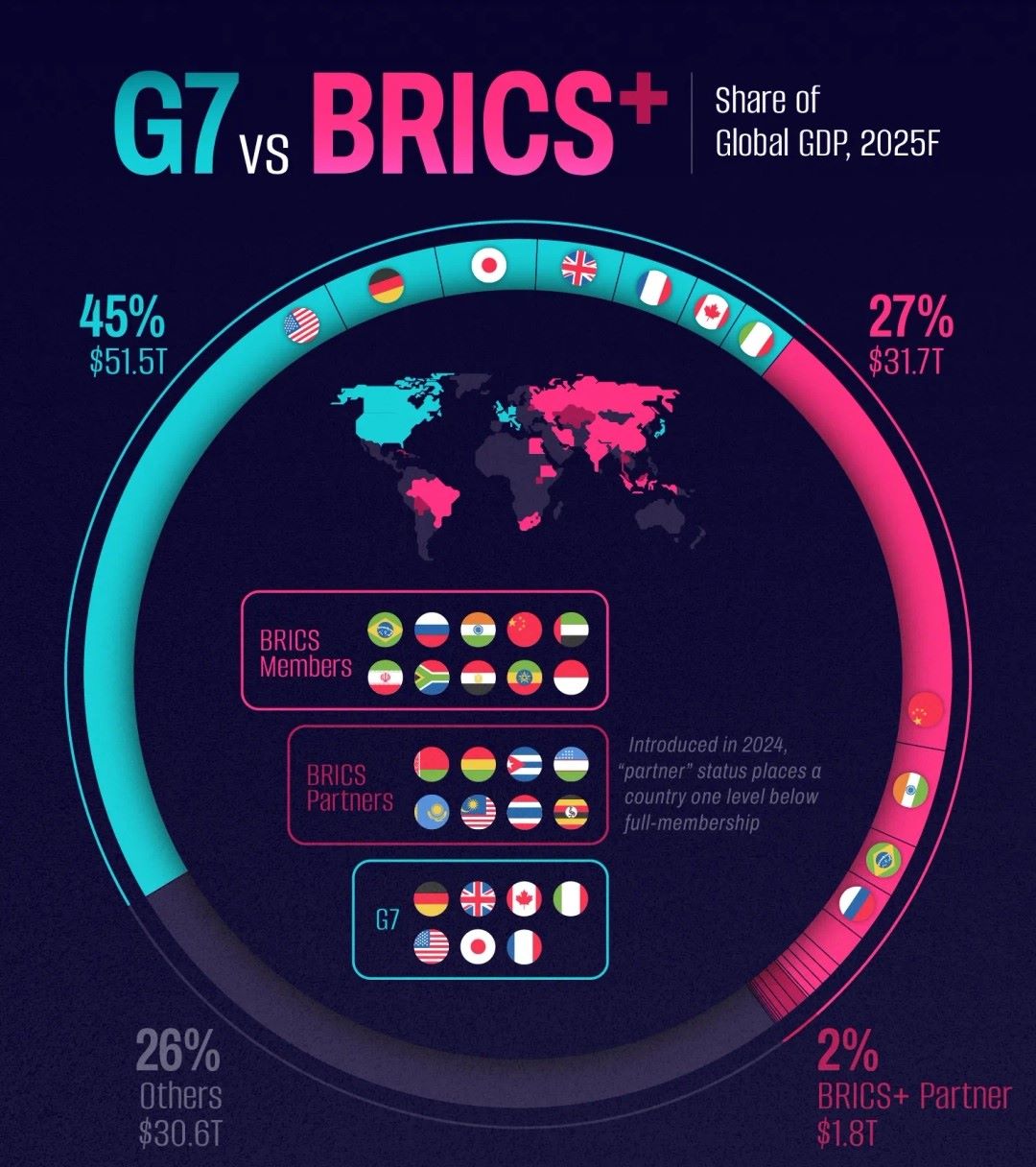BRICS vs. G7 Economies: Who's Stronger?

The BRICS sphere is expanding, with five new members and eight new “partner” countries joining in the past year.
How does this new emerging geopolitical bloc compare with the current leaders in economic and political power?
This chart shows how the BRICS countries compare to the G7 countries by tracking each bloc's combined share of the global economy in 2025.
All data are from the International Monetary Fund. The share was calculated based on nominal GDP forecasts measured in current US dollars. Figures have been rounded.
BRICS vs. G7: Share of the Global Economy
The 10-nation BRICS+ bloc will account for about 29% of the global economy in 2025, which is still dominated by the G7.
| Country | Group | GDP 2025 (US$ billion) |
|---|---|---|
| USA | G7 | $30,337 USD |
| Germany | G7 | $4922 |
| Japan | G7 | 4389 US dollars |
| United Kingdom | G7 | 3730 US dollars |
| France | G7 | $3283 |
| Canada | G7 | 2330 US dollars |
| Italy | G7 | 2460 US dollars |
| China | BRICS | $19,535 USD |
| India | BRICS | $4272 |
| Brazil | BRICS | 2307 US dollars |
| Russia | BRICS | 2196 US dollars |
| Indonesia | BRICS+ | $1,493 |
| UAE | BRICS+ | $569 |
| $115,494 |
A quick reminder of who/what BRICS is.
The acronym BRICS was originally used as a way to denote investment opportunities in fast-growing economies in the 2000s.
Since then, the five founding countries (Brazil, Russia, India, China, South Africa) have tried to create a platform that supports a multipolar world. They have prioritized the creation of global institutions parallel to those primarily funded by the G7 countries.
There is also talk of the BRICS countries creating a common currency for trade and abandoning the dollar.
A huge benefit of abandoning the dollar would be the ability to avoid financial sanctions that currently restrict global trade with at least two bloc countries, Russia and Iran.
However, a new BRICS currency is unlikely due to the vastly different economic structures of the member countries. On the other hand, more intra-block trading could take place in national currencies.
For example, India has already used its currency (rupees) to buy crude oil from the UAE.
Geopolitics in the BRICS Invitation Game
The proposal to join the BRICS founders was met with mixed reactions on the world stage. Several countries have joined, including the UAE, Iran, Egypt, Ethiopia and, most recently, Indonesia.
Others have taken a more cautious approach, opting to become a "partner" country, one step below full membership.
| Founders of BRICS | New BRICS+ members | BRICS+ Partners | We invite you to join BRICS+ |
|---|---|---|---|
| Brazil | UAE | Belarus | Saudi Arabia (expected) |
| Russia | Iran | Bolivia | Argentina (Rejected) |
| India | Egypt | Cuba | N/A |
| China | Ethiopia | Kazakhstan | N/A |
| South Africa | Indonesia | Malaysia | N/A |
| N/A | N/A | Thailand | N/A |
| N/A | N/A | Uganda | N/A |
| N/A | N/A | Uzbekistan | N/A |
Their caution is not without reason. Some, like Vietnam, rely heavily on trade with the U.S. and will not seek to anger their largest export market.
Another key US ally, Saudi Arabia, has been invited to join BRICS but has yet to respond. Argentina's Javier Miley has flatly refused to join, wanting closer ties with America.



















